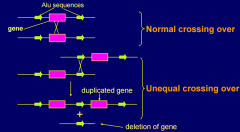![]()
![]()
![]()
Use LEFT and RIGHT arrow keys to navigate between flashcards;
Use UP and DOWN arrow keys to flip the card;
H to show hint;
A reads text to speech;
34 Cards in this Set
- Front
- Back
|
What is the C-value paradox? |
- Genome size is not proportional to complexity of organism - similar organisms (pufferfish and lungfish) may have greatly differing genome sizes |
|
|
What is a possible reason for similar organisms having different genome sizes? |
- it is mostly due to difference in amount of repetitive DNA |
|
|
Is there any correlation at all between genome size for a class of organisms and complexity? |
- there is a correlation between minimum genome size and complexity |
|
|
What is project encode? |
- Identification of all RNAs transcribed from the genome and all functional DNA sequences |
|
|
What are some common types of variations between the genomes of individuals? |
- single nucleotide polymorphism - short insertion/deletions (indels) - copy number variations (CNV) |
|
|
How many gaps are there in the in the human genome project sequence? |
- almost 300 |
|
|
What are the two different types of chromatin? |
- Heterochromatin |
|
|
What are the two types of euchromatin? |
- genes - Intergenic DNA |
|
|
What are the four types of intergenic DNA? |
- Repetitive DNA - Pseudogenes - Structural DNA (telomeres, centromeres) - other |
|
|
What are the two different types of repetitive DNA? |
- interspersed repeats - Tandem repeats |
|
|
What are the two types of genes? |
- Functional RNA (non-coding) - Protein coding |
|
|
What are the four types of functional RNA? |
- tRNA - rRNA - Small RNAs snoRNA, snRNA; miRNA, piRNA - long non-coding RNAs- structural enzymic OR regulatory |
|
|
What percentage do the different types of sequence take in the genome? |
- Exons - 2.9 (1.2 coding) - Introns - 36.6 - Intergenic DNA - 60.5 |
|
|
What are tandem repeats? |
- short repetitive sequences present in clusters, each of which contain many copies of the repeat |
|
|
What are the four types of interspersed repeats> |
- DNA transposons - LINEs - SINEs - endogenous retroviruses ALSO only LINEs and SINEs are active |
|
|
What are DNA transposons derived from? |
- derived from transposons that transpose via a DNA intermediate using "cut and paste" |
|
|
What are the LINEs, SINEs and Endogenous viruses derived from? |
- from transposons that transpose via an RNA intermediate (retrotransposons) using a "copy and paste" mechanism |
|
|
Why are human DNA transposons not transposable? |
- because all of them have acquired mutations that prevent their transposition = DNA fossils |
|
|
Where are endogenous retroviruses derived from? |
- retroviruses whose DNA integrated into the genome during infection of a germ line cell |
|
|
How do LINEs transpose? |
- via an RNA intermediate. - encode their own reverse transcriptase - use chromosomal DNA as primer |
|
|
What are the two classes of flanking repeat sequences? |
- direct repeat - on cis strand - inverted repeat - on trans strand |
|
|
Talk about the activity of LINEs |
- almost all including all LINE2 and LINE3 are inactive because LINE elements usually lick DNA from 5'end - 100 active LINE1 elements |
|
|
When do LINEs show highest activity? |
- during embryonic activity |
|
|
What percentage of spontaneous mutations is caused by LINE1? |
- 0.1% |
|
|
What are examples of diseases caused by LINE1 transposition mutations? |
- muscular dystrophy - haemophilia - LINE1 into F8 - thalassemia |
|
|
Where are SINEs derived from? |
- RNAs synthesised by RNA polymerase III - promoters recognised by RNA polymerase III may be located downstream of the transcription start site: Many SINEs have their own promoter and can be transcribed |
|
|
What is the most important human SINE? |
- The Alu sequence - The Alu sequence is the only SINE active in transposition - Alu transposition may cause genetic disorders e.g. some cases of muscular dystrophy, Tay-Sachs etc |
|
|
How are SINEs transposed? |
- The same way as LINEs - Use chromosomal DNA as primers |
|
|
LINEs and SINEs are built in mutagens |

- deletions can be caused by recombination between two nearby Alu or LINE elements. - They may arise from unequal crossing over between repeats |
|
|
What are the possible functions of interspersed repeat DNA? |
- May drive evolutionary change - may be involved in X inactivation - may have some role in gene regulation - genes may derive from heavily mutated repetitive sequences |
|
|
What is possible proof that interspersed repeat DNA may drive evolutionary change? |
- aproximately 850 kbp have been deleted from human genome BECAUSE of recombination between LINE1 or Alu sequences in the last 6mln years |
|
|
What is possible evidence that interspersed repeat DNA may be involved in X chromosome inactivation?
|
- LINE1 occurs with 2x higher frequency on X chromosome than on autosomes |
|
|
What is possible evidence that interspersed repeat DNA may be involved in gene regulation? |
- SINEs are more common in gene-rich than in gene-poor regions |
|
|
- What is possible evidence that interspersed repeat DNA may produce new genes? |
- Mammalian RAG1 recombinase is derived from a DNA transposon |

